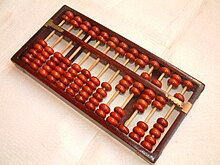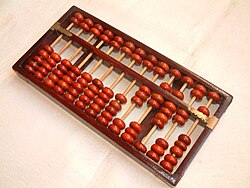算盤
Chinese[edit]
regard as; to figure; to calculate regard as; to figure; to calculate; to compute |
dish; tray; to build dish; tray; to build; to check; to examine; to transfer; (a measure word used for dishes of food or coils of wire); to coil | ||
|---|---|---|---|
| trad. (算盤) | 算 | 盤 | |
| simp. (算盘) | 算 | 盘 | |
| alternative forms | 筭盤/筭盘 | ||
| anagram | 盤算/盘算 | ||
Pronunciation[edit]

Noun[edit]
算盤
- (mathematics) abacus
- (figurative) plan; plan of action; master plan
Synonyms[edit]
- (abacus):
Derived terms[edit]
Descendants[edit]
- → Bouyei: suansbaanz, suansbeanz
- → English: suanpan
- → Hlai: duixbhuas
- → Japanese: 算盤 (soroban)
- → Malay: sempoa, sepua, cepua, suipoa
- → Mongolian: ᠰᠤᠸᠠᠨᠫᠠᠨ (suwanpan) / сампин (sampin)
- → Zhuang: suenqbuenz
Japanese[edit]

Etymology 1[edit]
| Kanji in this term | |
|---|---|
| 算 | 盤 |
| そろ Grade: 2 |
ばん Grade: S |
| irregular | goon |
| Alternative spellings |
|---|
| 十露盤 曾呂盤 珠盤 揃盤 三羅盤 (possibly read as saraban) |
Japanese sources consistently describe the abacus itself as being imported to Japan from China some time during the Muromachi period (1336–1573), although there is some disagreement as to whether this happened early in the period,[1] or late.[2][3][4][5]
First attested with the reading soroban in the 1595 trilingual Latin-Portuguese-Japanese dictionary Dictionarium Latino Lusitanicum, Ac Iaponicum, also 羅葡日対訳辞書 (Ra-Ho-Nichi Taiyaku Jisho, “Latin-Portuguese-Japanese Translation Dictionary”) based on work originally by Ambrogio Calepino,[6] corroborated in the Nippo Jisho of 1603.[2][7]
Japanese sources generally describe the soroban reading as a shift or corruption from the reading swanpan, the 唐音 (tōon, literally "Tang sound", referring to the Chinese-derived kanji readings that were borrowed into Japanese during the Tang dynasty or later) for the kanji spelling.[2][5] However, this is problematic on phonological grounds:
- There is no known phonological process whereby swan would become soro in Japanese.
- Middle Chinese swan consistently became Japanese san in all other known instances of the Chinese reading swan for any kanji character.
- The character 算 appearing as the first character in 算盤 (soroban) is also read as san, and san is similarly listed as a synonym for soroban in the 1595 dictionary entry.[6]
An alternative, albeit speculative, explanation is that this soro- is some other morpheme unrelated to the Chinese. If so, this might be native root soro-, as seen in adverb そろそろ (sorosoro, “quietly and calmly”), そろり (sorori) and そろっと (sorotto, “quietly and smoothly; slidingly, glidingly”), verb 揃う (sorou, “to be in alignment; to be in order; to match, to go together”).
Notably, this term appears historically with the alternative kanji spelling 三羅盤. Given the expected Japanese readings of these characters, this may have been read as saraban. Root sara- -- and also root suru- -- also appear in various terms related to senses of smooth, gliding, sliding.
Pronunciation[edit]
Noun[edit]
- [from 1595] (mathematics) an abacus
Derived terms[edit]
- 算盤占い (soroban'uranai)
- 算盤が合う (soroban ga au)
- 算盤が持てない (soroban ga motenai)
- 算盤勘定 (sorobankanjō)
- 算盤木 (sorobangi)
- 算盤桟手 (sorobansade)
- 算盤絞り (sorobanshibori)
- 算盤尽く (sorobanzuku)
- 算盤責め (sorobanzeme)
- 算盤高い (sorobandakai)
- 算盤玉 (sorobandama)
- 算盤の玉はずれ (soroban no tama wa zure)
- 算盤を置く (soroban o oku)
- 算盤を弾く (soroban o hajiku)
- 算盤を枕にする (soroban o makura ni suru)
Etymology 2[edit]
| Kanji in this term | |
|---|---|
| 算 | 盤 |
| さん Grade: 2 |
ばん Grade: S |
| on’yomi | goon |

Ultimately from Middle Chinese 算盤 (MC swanX ban, “abacus”, literally “calculation + board, grid”). Compare modern Min Nan reading sǹg-pôaⁿ, Mandarin suànpán.
Japanese sources consistently describe the abacus itself as being imported to Japan from China some time during the Muromachi period (1336–1573), although there is some disagreement as to whether this happened early in the period,[1] or late.[2][3][4][5]
First attested with the reading sanban to a text from 1688.[2]
Pronunciation[edit]
Noun[edit]
- [from 1688] (mathematics) a kind of grid used in 和算 (wasan, “traditional Japanese mathematics”) to calculate higher-order functions
- [from 1717] (mathematics) an abacus
References[edit]
- ↑ 1.0 1.1 “そろばん”, in ブリタニカ国際大百科事典 小項目事典 (Buritanika Kokusai Dai Hyakka Jiten: Shō Kōmoku Jiten, “Encyclopædia Britannica International: Micropædia”)[1] (in Japanese), Tōkyō: Britannica Japan Co., Ltd., 2014
- ↑ 2.0 2.1 2.2 2.3 2.4 Shōgaku Tosho (1988) 国語大辞典(新装版) [Unabridged Dictionary of Japanese (Revised Edition)] (in Japanese), Tōkyō: Shogakukan, →ISBN
- ↑ 3.0 3.1 Matsumura, Akira (1995) 大辞泉 (in Japanese), First edition, Tōkyō: Shogakukan, →ISBN
- ↑ 4.0 4.1 “算盤”, in 日本大百科全書:ニッポニカ (Nippon Dai Hyakka Zensho: Nipponica, “Encyclopedia Nipponica”)[2] (in Japanese), Tōkyō: Shogakukan, 1984
- ↑ 5.0 5.1 5.2 5.3 5.4 Matsumura, Akira, editor (2006), 大辞林 (in Japanese), Third edition, Tōkyō: Sanseidō, →ISBN
- ↑ 6.0 6.1 1595, Dictionarium Latino Lusitanicum, Ac Iaponicum (in Latin, Portuguese, and Japanese), 1979 reprint, Tōkyō: Bensei Publishing, text visible online in the Abáculus entry here
- ^ Ishizuka, Harumichi (1976 [1603]) 日葡辞書: パリ本 [Nippo Jisho: Paris edition / Vocabulary of the Language of Japan][3] (overall work in Japanese and Portuguese), Tōkyō: Bensei Publishing, text visible online here, two entries above the highlighted term
- ^ NHK Broadcasting Culture Research Institute, editor (1998), NHK日本語発音アクセント辞典 [NHK Japanese Pronunciation Accent Dictionary] (in Japanese), Tōkyō: NHK Publishing, →ISBN
- ^ Kindaichi, Kyōsuke et al., editors (1997), 新明解国語辞典 (in Japanese), Fifth edition, Tōkyō: Sanseidō, →ISBN
- Mandarin words containing toneless variants
- Chinese lemmas
- Mandarin lemmas
- Sichuanese lemmas
- Dungan lemmas
- Cantonese lemmas
- Taishanese lemmas
- Gan lemmas
- Hakka lemmas
- Jin lemmas
- Eastern Min lemmas
- Hokkien lemmas
- Teochew lemmas
- Wu lemmas
- Xiang lemmas
- Chinese nouns
- Mandarin nouns
- Sichuanese nouns
- Dungan nouns
- Cantonese nouns
- Taishanese nouns
- Gan nouns
- Hakka nouns
- Jin nouns
- Eastern Min nouns
- Hokkien nouns
- Teochew nouns
- Wu nouns
- Xiang nouns
- Chinese terms with IPA pronunciation
- zh:Mathematics
- Advanced Mandarin
- Japanese terms spelled with 算
- Japanese terms spelled with 盤 read as ばん
- Japanese terms with IPA pronunciation
- Japanese lemmas
- Japanese nouns
- Japanese terms with multiple readings
- Japanese terms spelled with second grade kanji
- Japanese terms spelled with secondary school kanji
- Japanese terms written with two Han script characters
- ja:Mathematics
- Japanese terms with usage examples
- Japanese terms spelled with 算 read as さん
- Japanese terms read with on'yomi
- Japanese terms derived from Middle Chinese
